2019 Volvo XC40
If you’re Volvo, how do you follow up the fantastic XC90 full-size and XC60 mid-size crossovers? Well, automotive logic would dictate things would continue to trickle down; and indeed they have, with an all-new, compact sized, 2019 Volvo XC40.
It may be Volvo’s smallest crossover yet, but it feels big for the class. And, it is the first modern Volvo not built on the SPA platform, but a new Compact Modular Architecture.
Looking taller and stubbier than its bigger kin, the XC40’s exterior is both bold and cartoonish. We also see traces of Land Rover and Jeep in its luxo-rugged design. There’s plenty to draw the eyes here; from the scooped out grille, deep body cuts, an available contrasting roof, and even a little Swedish flag sticking out from under the clamshell hood. Just don’t tell anyone it’s actually made in Belgium.
 Our tester is a T5, which in current Volvo-speak means the 2.0-liter I4 underneath the hood is turbo-charged. Sums of 248–horsepower and 258 lb.-ft. of torque put it well above class average.
Our tester is a T5, which in current Volvo-speak means the 2.0-liter I4 underneath the hood is turbo-charged. Sums of 248–horsepower and 258 lb.-ft. of torque put it well above class average.
An 8-speed automatic transmission and all-wheel-drive are standard with the T5. Volvo is of course, no stranger to the front-wheel-drive based all-wheel-drive game; having fielded examples for some 20-years, since the 850 Estate, becoming V70XC here in the states.
A naturally-aspirated, 2.0-liter, front-wheel-drive only, XC 40 T4 will arrive here later this year, with a plug-in hybrid and pure EV following that.
The suspension design, and our T5’s ride itself, favors that of its bigger kin; yet needless to say, its diminutive size makes it a breeze to whip around city streets, as well as in and out of traffic. Which you can do quite easily, with incredibly powerful response from the engine.
So, the XC40 squirts off the line quite efficiently as well, capable of hitting 60 in just 6.3-seconds. Power arrives early and stays, shifts click through quickly and smoothly, for a ¼-mile ending in 14.8-seconds at 95 miles-per-hour.
 The XC40 felt nimble and eager through our cone course. Steering is very light, yet we always had a good sense of where our wheels were pointing.
The XC40 felt nimble and eager through our cone course. Steering is very light, yet we always had a good sense of where our wheels were pointing.
There’s laser-like attention to interior details, with a wealth of sensible storage options throughout the cabin. On the flip side, the shortage of physical controls, and over reliance on a big touch screen, didn’t impress us.
When it comes to materials and theme, it’s totally Swedish; with pleasant-looking aluminum on the dash, nicely carpeted door panels, and fit-and-finish commensurate with rival luxury brand.
Size has not impacted the Volvo comfort we’ve come to expect, with a fairly high seating position; again, giving you the impression it’s a larger vehicle.
Rear seat legroom is quite good as well, with adequate headroom for most adults.
In back, there’s 20.7 cubic-ft. of cargo space, maxing out at 47.2 with the rear seats folded; not as roomy as some, but the space is flexible and very nicely finished.
 When it comes to safety systems, if Volvo has it, it’s here; and not just available, but standard.
When it comes to safety systems, if Volvo has it, it’s here; and not just available, but standard.
Government Fuel Economy Ratings are 23-City, 31-Highway, and 26-Combined. We saw a good 27.8 miles-per-gallon with the required Premium. The Energy Impact Score is an average one, at 12.7-barrels of yearly petroleum use, along with CO2 emissions of 5.6-tons.
If all of that wasn’t enough, you can buy one for a more than reasonable $34,195. The T5 with all-wheel-drive, starts at just $36,195. And with this vehicle, Volvo is also launching a new subscription service, that will allow you to get a vehicle including insurance and maintenance for one monthly payment, with no money down. And, much like the millennials they are going after probably already do with their smartphones, you can upgrade your vehicle after as little as one year.
But, what really matters, is that the 2019 Volvo XC40 delivers on all points, with a refined interior and ride quality found nowhere else in the compact segment. Now that Volvo has revamped their entire SUV lineup in just 3-years, it’s hard not seeing the XC40 following in the footsteps of XC90, and 60; which is to say, being another big success.
Specifications
- Engine: 2.0 liter
- Horsepower: 248
- Torque: 258 lb.-ft.
- 0-60 mph: 6.3 seconds
- 1/4 mile: 14.8 seconds @ 95 mph
- EPA: 23 mpg city / 31 mpg highway
- Energy Impact: 12.7 barrels of oil/yr
- CO2 Emissions: 5.6 tons/yr
2025 Buick Enclave
Buick’s Biggest Utility Gets More Premium Look, Less Premium Powertrain
Buick is now an all SUV brand with the three-row Enclave sitting at the top of their lineup. And for this all-new third generation, it looks like Buick has finally given it the true flagship treatment it deserves. Reason enough for us to see what else new this posh performer has in store.
Don’t think of this 2025 Buick Enclave as just a new third generation of Buick’s largest three-row SUV, but more of a total reboot for a luxury segment pioneer. Part of that reinvention is swapping out the 3.6-liter naturally aspirated V6 engine, that has been the heart of this large crossover since it arrived on the scene for 2008, for a new 2.5-liter turbocharged four-cylinder.
Though using two fewer cylinders, it rates 18 more horsepower at 328. The gain in torque is even greater, climbing from 266 to 326 lb-ft.
Power from a start and when tooling around town feels pretty good, but you do notice that engine working hard under the hood; there is more engine noise and it’s not as smooth as many competitors who have also made the switch to turbo-four power. Max towing rating remains at 5,000 lbs. The new standard automatic transmission loses a gear, dropping from nine to eight, a simplifying move we applaud. All-wheel drive is a $2,000 option with all trims.
The Enclave rides on the same front-wheel-drive based chassis that supports the Chevrolet Traverse and GMC Acadia. It remains the most luxurious of the three, though all have made big upward strides. And that luxurious feel is very evident inside where things appear special without flaunting it. Materials are vastly improved over the last gen, especially in top Avenir trim which is the choice for most Enclave buyers.
Front seats are very comfy, well suited for long days of highway travel. It’s hard to miss the 30-inch ultra-wide display, similar to Cadillac’s. It is big, but not intimidating as operation is very logical and you can easily configure things as you want them, including bringing the nav screen up full in front of the driver.
Front seats are very comfy, well suited for long days of highway travel.
Between the seats is a very substantial console with lots of storage space and standard wireless phone charging. There is definitely room for full-size adults in all three rows of seating. Big, plush captain’s chairs with all trims for the second row; and a less plush but still comfortable three-place third row.
GM’s Super Cruise has now made it to Buick’s lineup, available as a standalone package for any trim. It remains a favorite of ours for hands-off highway cruising. Despite feeling adequately powered on the street, the Enclave’s turbo-four felt a little out of its element at our Mason Dixon Dragway test track. There was very little jump off the line, just a slow wind up to 60 of 8.0 seconds, with the quarter-mile completed in 16.0 seconds flat at 92 mph.
We could really feel the Enclave’s weight in our handling course, about 150-lbs. over last year, even with less motor under the hood. But there was very little body roll, and no excessive oversteer or understeer. In panic braking runs, there was good feel through the pedal, and solid stops from 60 averaging a fine 111 feet.
To all of our eyes, the Enclave is bigger yet much better looking than before. Now more sophisticated using Buick’s PURE philosophy which emphasizes Purity in design, Unexpected details, Refined finishes, and Exceptional execution.
With all-wheel drive, Government Fuel Economy Ratings are 19 City, 24 Highway, and 21 Combined; we managed a great 24.9 mpg of Regular. That’s a slightly below average Energy Impact Score, consuming 14.2 barrels of oil yearly, with 7.0 tons of CO2 emissions.
No more Essence or Premium Enclaves, as the new gen brings new trim names along with it; the base option now being Preferred which starts at $46,395, and unless you choose white, you’ll be paying extra for all exterior colors. Just a short step from there to the Sport Touring for $48,795, and then a much bigger bounce up to Avenir at $59,395.
With so many big utes now aimed at luxury and near luxury buyers, it’s getting harder and harder for Buick to stand out. Being an all-utility brand, with one of the freshest lineups in the industry, will no doubt help. The 2025 Buick Enclave is a very stylish, well-equipped, well executed large three-row crossover that’s priced right.
Specifications
As Tested
- Engine: 2.5-liter turbo-4
- Transmission: 8-speed automatic
- Horsepower: 328
- Torque: 326 lb-ft.
- EPA: 19 City | 24 Highway | 21 Combined
- 0-60 mph: 8.0 seconds
- 1/4 Mile: 16.0 seconds at 92 mph
- Braking, 60-0 (avg.): 111 feet
- MW Fuel Economy: 24.9 mpg (Regular)



































